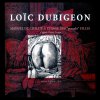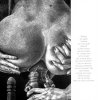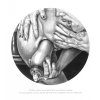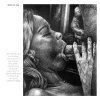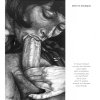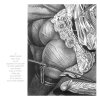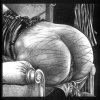nsur1
Governor
I am not sure this classic female crucifixion scene has been posted here before. The 1896 French historic/erotic novel "Aphrodite: moeurs antiques" by Pierre Louÿs has a lengthy and brutal scene of the crucifixion of the female slave Aphrodisia, wrongly suspected of theft. The French original is here, and there are two different English translations here and here - the first one is the better and I reproduce the crucifixion scene below. Here are five images depicting the scene -- #1 is from the French first edition of the book (not a very practical cross, if you ask me), #2, #3 and #4 from the English editions, and #5 is an oil painting by Raphael Collin (courtesy of Phlebas):
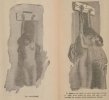
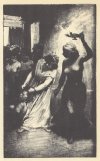
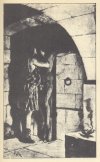

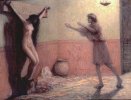
They all repeated together:
“It is Aphrodisia who has taken it! Bitch! Bitch! Filthy thief!”
Their hatred of the favourite sister was reinforced by their fear for themselves.
Aretias gave her a kick in the breast.
“Where is it?” asked Bacchis. “Where have you put it?”
“She has given it to her lover.”
“Who is he?”
“An Opian sailor.”
“Where is his ship?”
“It sailed this evening for Rome. You will never see your mirror again. Let us crucify the bitch, the bloody animal!”
“Ah! Gods! Gods!” sobbed Bacchis.
Then suddenly her sorrow changed into a frenzy of rage.
Aphrodisia had come to herself again; but, paralysed by terror, and unable to understand what was happening, she remained speechless and tearless.
Bacchis seized her by the hair, dragged her over the soiled floor, through the flowers and pools of wine, and cried:
“The cross! the cross! bring the nails! bring the hammer!”
“Oh!” said Seso to her neighbour; “I have never seen that. Let us follow them.”
All pressed forward to follow. And Chrysis, who alone knew the guilty one, and was alone the cause of everything, Chrysis followed too.
Bacchis went straight into the slaves’ chamber, a square apartment furnished with three mattresses on which they slept in couples when the nights were over. At the lower end, like an ever-present menace, stood a T-shaped cross which had never yet been used.
In the midst of the confused murmur of the young men and women, four slaves hoisted the martyr to the level of the branches of the cross.
Not a sound had yet left her lips; but when she felt the touch of the cold rough beam on her naked back, her long eyes dilated, and she was seized with a convulsive fit of groaning which lasted till the end.
They put her astride on a wooden peg driven into the centre of the upright. This served to support the body and obviate the tearing of the hands.
Then they opened out her arms.
Chrysis looked on and held her peace. What could she say? She could only have exonerated the slave by incriminating Demetrios, who was beyond reach of all attack, and who would have taken a cruel revenge. Besides, a slave was a source of riches, and it was a satisfaction to the long-standing grudge that Chrysis bore her enemy to think that she was destroying in this way with her own hands the value of three thousand drachmæ as completely as if she had thrown the money into the Eunostis. And then, was the life of a minion worth troubling about?
Heliope handed Bacchis the first nail and the hammer, and the torture began. Intoxication, rancour, anger, all the passions together, even the instinct of cruelty which lurks in a woman’s heart, animated the soul of Bacchis at the moment she struck, and she uttered a shriek almost as piercing as that of Aphrodisia when the nail bent in the open palm.
She nailed up the second hand. She nailed the feet one upon the other. Then, excited by the sight of the blood spurting from the three wounds, she cried:
“It is not enough! Thief! Sow! Sailors’ strumpet!”
She took the long pins out of her hair, and dug them violently into the flesh of her breasts, the belly, and the thighs. When she had no more weapons left in her hands, she smacked the poor wretch and spat upon her.
She contemplated this work of vengeance for some time; then she returned into the banqueting-hall with all the guests.
Phrasilas and Timon alone did not follow her.
---
After a moment’s silent meditation, Phrasilas coughed slightly, put his right hand into his left, raised his head, lifted his eyebrows, and drew near the crucified one, whose body shook with a continuous, horrible trembling.
“Although I am,” he said to her, “in divers circumstances, opposed to absolute theories so-called, yet I cannot blind myself to the fact that, in the conjuncture which has overtaken you, you would gain by being familiarised in more solid fashion with the maxims of the Stoics. Zeno, who does not seem to have had a spirit completely exempt from error, has left us several sophistries of no great general import, but, at the same time, you might derive profit from them to the particular end of calming your last moments.
“Pain”, he said, “is a word void of meaning, since our will transcends the imperfections of our perishable body. It is true that Zeno died at the age of ninety-eight, without ever having had, according to his biographers, any illness, however slight; but this circumstance cannot be used as an argument against him, for from the mere fact that he succeeded in maintaining an unimpaired good health, we cannot logically conclude that he would have been lacking in force of character had he fallen ill. Besides, it would be an abuse to compel the philosophers to practise in their persons the rules of conduct they profess, and to cultivate without respite the virtues they deem superior. In a word, not to prolong inordinately a discourse which might last longer than yourself, endeavour to lift up your soul, my dear, as far as possible, above your physical sufferings. However melancholy, however cruel they may appear to you, I beg you to believe that I have a real part in them. They are drawing to a close: be patient, forget. Between the various doctrines which attribute immortality to us, this is the moment for choosing the one most fitted to alleviate your regrets at having to disappear. If these doctrines are true, you will have lightened the bitter agony of the passage. If they lie, what does it matter? You will never know that you were mistaken.”
Having spoken thus, Phrasilas re-adjusted the folds of his garment over his shoulder and vanished with an unsteady gait.
Timon remained alone in the room with the woman hanging in the throes of death upon the cross.
The memory of a night passed on the poor wretch’s breast haunted his brain, and confounded itself with the atrocious vision of the imminent rottenness into which this splendid body that had burned in his arms was about to fall.
He pressed his hand over his eyes in order not to see her torture, but he heard the unceasing trembling of the body upon the cross.
Finally, he looked. Great threads of blood formed a network on the skin from the pins in the breast down to the curled-up heels. The head turned perpetually. All the hair, matted with blood, sweat, and perfume, hung over the left side.
“Aphrodisia! do you hear me! do you recognise me? It is I, Timon; Timon.”
Her glance, almost blind, rested on him for a second. But the head turned incessantly. The body trembled continually.
Softly, as if he feared the sound of his foot-steps would hurt her, the young man advanced to the foot of the cross. He stretched out his arms, he carefully took her strengthless and ever-turning head between his two fraternal hands, piously smoothed away her tear-drenched hair from her cheeks, and imprinted on the hot lips a kiss of infinite tenderness.
Aphrodisia closed her eyes. Did she recognise him who had charmed her horrible end by this impulse of affectionate pity? An inexpressible smile distended her blue eyelids, and with a sigh she gave up the ghost.





THE CRUCIFIED ONE
They all repeated together:“It is Aphrodisia who has taken it! Bitch! Bitch! Filthy thief!”
Their hatred of the favourite sister was reinforced by their fear for themselves.
Aretias gave her a kick in the breast.
“Where is it?” asked Bacchis. “Where have you put it?”
“She has given it to her lover.”
“Who is he?”
“An Opian sailor.”
“Where is his ship?”
“It sailed this evening for Rome. You will never see your mirror again. Let us crucify the bitch, the bloody animal!”
“Ah! Gods! Gods!” sobbed Bacchis.
Then suddenly her sorrow changed into a frenzy of rage.
Aphrodisia had come to herself again; but, paralysed by terror, and unable to understand what was happening, she remained speechless and tearless.
Bacchis seized her by the hair, dragged her over the soiled floor, through the flowers and pools of wine, and cried:
“The cross! the cross! bring the nails! bring the hammer!”
“Oh!” said Seso to her neighbour; “I have never seen that. Let us follow them.”
All pressed forward to follow. And Chrysis, who alone knew the guilty one, and was alone the cause of everything, Chrysis followed too.
Bacchis went straight into the slaves’ chamber, a square apartment furnished with three mattresses on which they slept in couples when the nights were over. At the lower end, like an ever-present menace, stood a T-shaped cross which had never yet been used.
In the midst of the confused murmur of the young men and women, four slaves hoisted the martyr to the level of the branches of the cross.
Not a sound had yet left her lips; but when she felt the touch of the cold rough beam on her naked back, her long eyes dilated, and she was seized with a convulsive fit of groaning which lasted till the end.
They put her astride on a wooden peg driven into the centre of the upright. This served to support the body and obviate the tearing of the hands.
Then they opened out her arms.
Chrysis looked on and held her peace. What could she say? She could only have exonerated the slave by incriminating Demetrios, who was beyond reach of all attack, and who would have taken a cruel revenge. Besides, a slave was a source of riches, and it was a satisfaction to the long-standing grudge that Chrysis bore her enemy to think that she was destroying in this way with her own hands the value of three thousand drachmæ as completely as if she had thrown the money into the Eunostis. And then, was the life of a minion worth troubling about?
Heliope handed Bacchis the first nail and the hammer, and the torture began. Intoxication, rancour, anger, all the passions together, even the instinct of cruelty which lurks in a woman’s heart, animated the soul of Bacchis at the moment she struck, and she uttered a shriek almost as piercing as that of Aphrodisia when the nail bent in the open palm.
She nailed up the second hand. She nailed the feet one upon the other. Then, excited by the sight of the blood spurting from the three wounds, she cried:
“It is not enough! Thief! Sow! Sailors’ strumpet!”
She took the long pins out of her hair, and dug them violently into the flesh of her breasts, the belly, and the thighs. When she had no more weapons left in her hands, she smacked the poor wretch and spat upon her.
She contemplated this work of vengeance for some time; then she returned into the banqueting-hall with all the guests.
Phrasilas and Timon alone did not follow her.
---
After a moment’s silent meditation, Phrasilas coughed slightly, put his right hand into his left, raised his head, lifted his eyebrows, and drew near the crucified one, whose body shook with a continuous, horrible trembling.
“Although I am,” he said to her, “in divers circumstances, opposed to absolute theories so-called, yet I cannot blind myself to the fact that, in the conjuncture which has overtaken you, you would gain by being familiarised in more solid fashion with the maxims of the Stoics. Zeno, who does not seem to have had a spirit completely exempt from error, has left us several sophistries of no great general import, but, at the same time, you might derive profit from them to the particular end of calming your last moments.
“Pain”, he said, “is a word void of meaning, since our will transcends the imperfections of our perishable body. It is true that Zeno died at the age of ninety-eight, without ever having had, according to his biographers, any illness, however slight; but this circumstance cannot be used as an argument against him, for from the mere fact that he succeeded in maintaining an unimpaired good health, we cannot logically conclude that he would have been lacking in force of character had he fallen ill. Besides, it would be an abuse to compel the philosophers to practise in their persons the rules of conduct they profess, and to cultivate without respite the virtues they deem superior. In a word, not to prolong inordinately a discourse which might last longer than yourself, endeavour to lift up your soul, my dear, as far as possible, above your physical sufferings. However melancholy, however cruel they may appear to you, I beg you to believe that I have a real part in them. They are drawing to a close: be patient, forget. Between the various doctrines which attribute immortality to us, this is the moment for choosing the one most fitted to alleviate your regrets at having to disappear. If these doctrines are true, you will have lightened the bitter agony of the passage. If they lie, what does it matter? You will never know that you were mistaken.”
Having spoken thus, Phrasilas re-adjusted the folds of his garment over his shoulder and vanished with an unsteady gait.
Timon remained alone in the room with the woman hanging in the throes of death upon the cross.
The memory of a night passed on the poor wretch’s breast haunted his brain, and confounded itself with the atrocious vision of the imminent rottenness into which this splendid body that had burned in his arms was about to fall.
He pressed his hand over his eyes in order not to see her torture, but he heard the unceasing trembling of the body upon the cross.
Finally, he looked. Great threads of blood formed a network on the skin from the pins in the breast down to the curled-up heels. The head turned perpetually. All the hair, matted with blood, sweat, and perfume, hung over the left side.
“Aphrodisia! do you hear me! do you recognise me? It is I, Timon; Timon.”
Her glance, almost blind, rested on him for a second. But the head turned incessantly. The body trembled continually.
Softly, as if he feared the sound of his foot-steps would hurt her, the young man advanced to the foot of the cross. He stretched out his arms, he carefully took her strengthless and ever-turning head between his two fraternal hands, piously smoothed away her tear-drenched hair from her cheeks, and imprinted on the hot lips a kiss of infinite tenderness.
Aphrodisia closed her eyes. Did she recognise him who had charmed her horrible end by this impulse of affectionate pity? An inexpressible smile distended her blue eyelids, and with a sigh she gave up the ghost.




